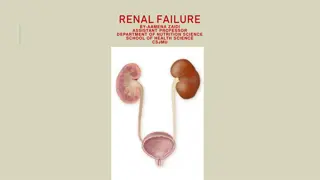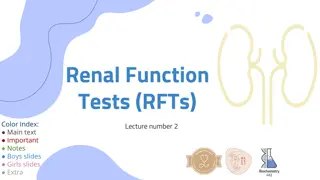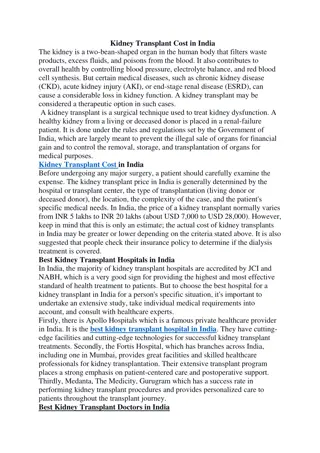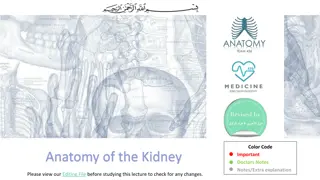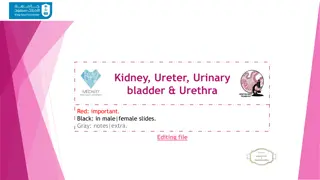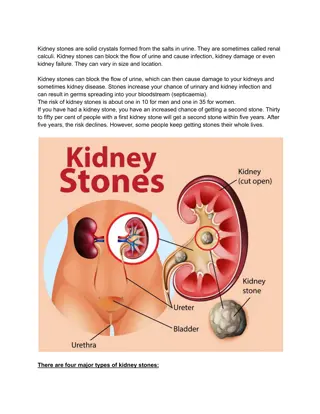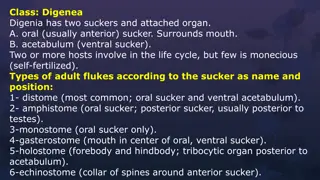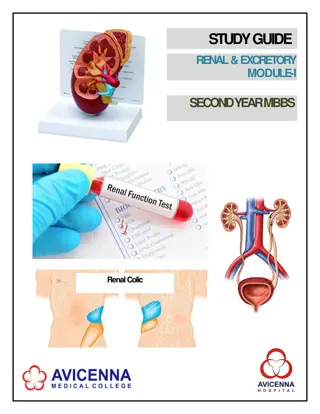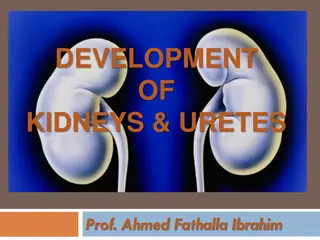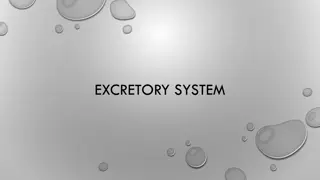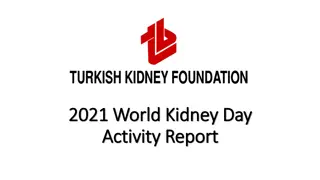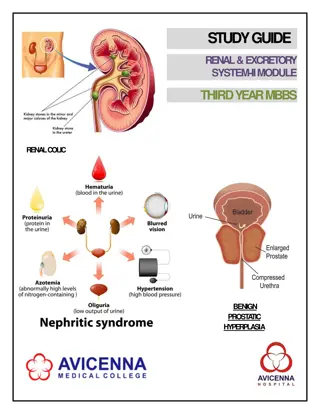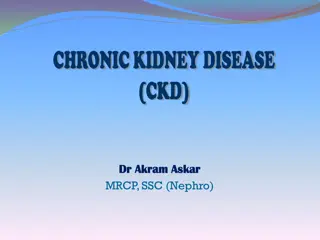Excretory System Overview and Human Kidney Structure
The excretory system plays a crucial role in eliminating waste products from the body. This overview covers excretory products and their elimination in different organisms, focusing on the structure and function of the human excretory system, specifically the kidneys. Learn about nephrons, urine formation, and the glomerular filtration rate (GFR) in this comprehensive guide.
Download Presentation

Please find below an Image/Link to download the presentation.
The content on the website is provided AS IS for your information and personal use only. It may not be sold, licensed, or shared on other websites without obtaining consent from the author.If you encounter any issues during the download, it is possible that the publisher has removed the file from their server.
You are allowed to download the files provided on this website for personal or commercial use, subject to the condition that they are used lawfully. All files are the property of their respective owners.
The content on the website is provided AS IS for your information and personal use only. It may not be sold, licensed, or shared on other websites without obtaining consent from the author.
E N D
Presentation Transcript
Chapter Chapter- -16 16 Excretory Products and Their Excretory Products and Their Elimination Elimination 1
EXCRETORY PRODUCTS AND THEIR ELIMINATION Excretory system helps in collecting nitrogenous waste and expelling it outside the body. Specific excretory organs Platyhelminthes, rotifers, some annelids and Cephalochordate Earthworms Insects crustaceans Protonephridia or flame cells Nephridia Malpighian tubules Antennal glands 2/10
HUMAN EXCRETORY SYSTEM It consists of a pair of kidneys, one pair of ureters, a urinary bladder and a urethra. Kidneys: reddish brown, bean-shaped structures Size: 10-12 cm in length, 5-7 cm in width, 2-3 cm in thickness, weight: 120- 170 g. The kidney has an outer cortex, inner medulla and pelvis. The medulla is divided into a few conical tissue masses called medullary pyramids / renal pyramids. The part of the cortex that extends in between the medullary pyramids is the renal columns of Bertini. At the center of the concave surface of the kidney, a notch (hilum) is present. Through t he hilum ureter, blood vessels and nerves enter the kidney. 3/10
Inner to the hilum is a broad funnel-shaped space (renal pelvis) located with projections called calyces. The calyces collect the urine and empties it into the ureter, which is stored in the urinary bladder temporarily. The urinary bladder opens into the urethra through which urine is expelled. Each kidney has nearly one million nephrons (functional units of the kidney). The Malpighian corpuscle, PCT, DCT are situated in the cortical region while loops of Henle into the medulla. The efferent arteriole emerging from the glomerulus forms a fine capillary network around the renal tubule called the peritubular capillaries. 4/10
Types of nephrons Cortical nephrons: loop of Henle is too short and extends only very little into the medulla. Medullary nephrons: Loops of Henle are very long and run deep into the medulla. 5
URINE FORMATION The nitrogenous waste formed as a result of the breakdown of amino acids is converted to urea in the liver by the Ornithine cycle or urea cycle. G 6/10
GFR (glomerular filtration rate): The amount of filtrate formed by the kidneys per minute (125 ml/minute) is called (GFR). Regulation of GFR: The juxta glomerular apparatus (JGA) is formed by cellular modifications in the DCT and the afferent arteriole at the location of their contact. When GFR decreases, the JG cells release renin, which stimulates the glomerular blood flow and therebythe GFR back to normal. 7/10
Mechanism of concentration of the filtrate The filtrate flows in opposite directions in the two limbs of Henle's loop, forming a counter current. Blood also flows in a counter-current pattern through the two limbs of the vasa recta. The close proximity of the Henle's loop and the vasa recta, as well as the countercurrent in them,help to maintain a rising osmolarity towards the inner medullary interstitium. The ascending limb of Henle's loop transports NaCl, which is exchanged with the descending limb ofthe vasa recta. The ascending section of the vasa recta returns NaCl to the interstitium. Small amounts of urea enter the ascending limb of Henle's loop's thin segment, which is then carriedback to the interstitium by the collecting tubule. This causes the concentration of urine. Human kidneys can produce urine nearly four times moreconcentrated than the initial filtrate formed. 10/10
Regulation of kidney function ADH (antidiuretic hormone)/ Vasopressin - released from neurohypophysis. It facilitates water reabsorption from the latter parts of the tubule, thereby preventing diuresis. The ADH can contract blood vessels and therefore increase blood pressure. An increase in blood pressure can increase the GFR. JGA- A fall in glomerular blood flow/glomerular blood pressure/GFR can activate the JG cells to release renin. Renin converts angiotensinogen in blood to angiotensin I and then to angiotensin II. Angiotensin II is a powerful vasoconstrictor and increases glomerular blood pressure and therebyGFR. Aldosterone-angiotensin II also activates the adrenal cortex to release Aldosterone. Aldosterone causes the reabsorption of Na+ and water from the DCT. This also leads to an increase in blood pressure and GFR. This complex mechanism is generally known as the Renin-Angiotensin mechanism ANF (Atrial Natriuretic Factor): An increase in blood flow to the atria of the heart can cause the release of ANF. It can cause vasodilation and thereby decrease the blood pressure. ANF acts antagonistically to the renin- angiotensin system, aldosterone and vasopressin. 12
Micturition The process of release of urine from the bladder is called micturition. The signal is sent by CNS to relax the urethra sphincter and cause urination. Role of other organs in excretion Lungs: remove approx. 200mL/ minute CO2 and significant quantities of water. Liver: secretes bile-containing substances like bilirubin, biliverdin, cholesterol, degraded steroid hormones, vitamins and drugs. Most of these substances ultimately pass out along with digestive wastes. Skin: Sweat produced by the sweat glands is a watery fluid containing NaCl, small amounts of urea, lactic acid, etc. Sebaceous glands eliminate certain substances like sterols, hydrocarbons and waxes through sebum. 13/10
Disorders of the excretory system Uremia: accumulation of urea in the blood Renal calculi: Stone or insoluble mass of crystallized salts (oxalates, etc.) Glomerulonephritis: Inflammation of glomeruli of the kidney Hemodialysis A dialyzing machine (artificial kidney) is connected to the patient s body. The machine consists of a long cellulose tube surrounded by the dialyzing fluid in a water bath. The patient s blood is drawn from a convenient artery and pumped into the dialyzing unit after adding an anticoagulant like heparin. 14
The tiny pores in the such as glucose, salts and urea to enter the water bath, whereas blood cells and protein molecules do not enter these pores (Similar to glomerular filtration). dialysis tube allow small molecules The cleared blood is then pumped back into the body through a vein. Kidney Transplantation It is the ultimate method for the correction of acute renal failures. This involves the transfer of a healthy kidney from one person (donor) to another person with kidneyfailure. Immunosuppressive drugs are usually administered to the patient to avoid tissue rejection. 15
THANK YOU THANK YOU 16


